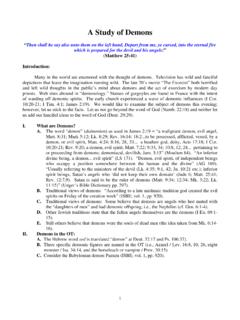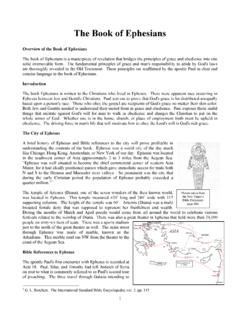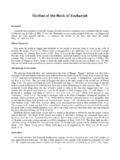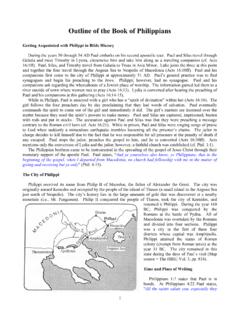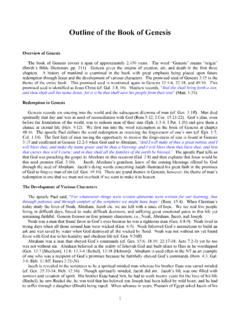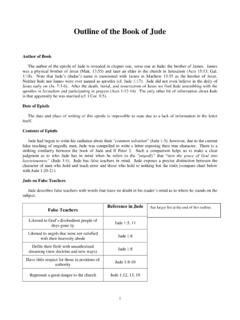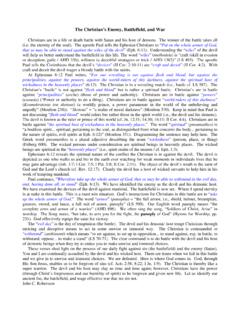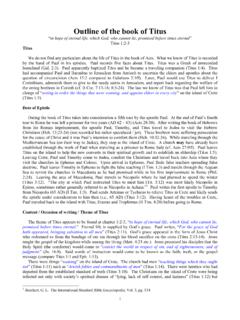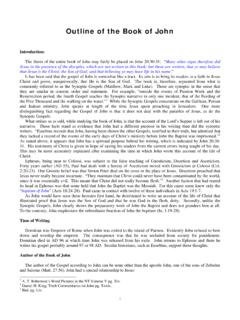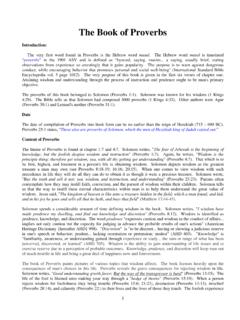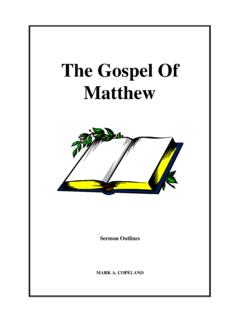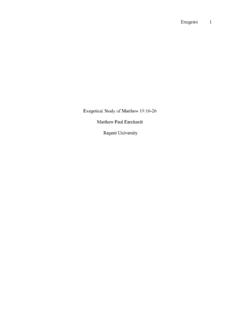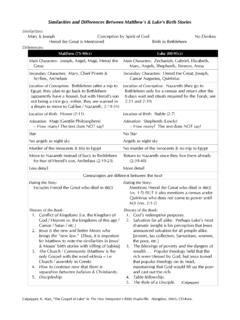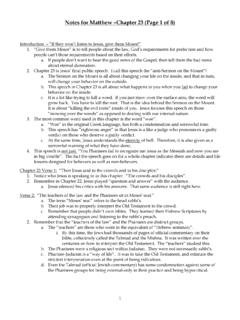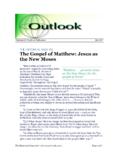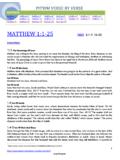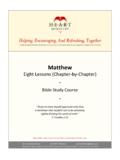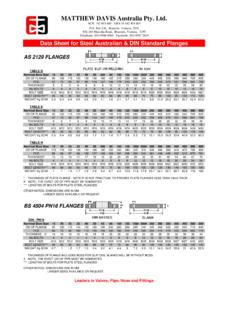Transcription of Outline of the Book of Matthew - Floral Heights …
1 1 Outline of the book of Matthew Introduction: Matthew 1:1 sets forth the theme of this study, The book of the generation (birth) of Jesus Christ, the son of David, the son of Abraham. The caption in the American Standard Version Bible reads, The Gospel: according to Matthew . The word gospel is equated to good news. Jesus represents good news because He came into the world to save sinners from the condemnation of sin (Matt. 1:21). The apostle Paul writes, Faithful in the saying, and worthy of all acceptation, that Christ Jesus came into the world to save sinners; of whom I am chief: (I Tim. 1:15). The apostle John writes, For the law was given through Moses; grace and truth came through Jesus Christ (Jn.)
2 1:17). Grace is identified in the New Testament as the forgiveness of sins (cf. Eph. 1:7; Rom. 5:1-2). Paul tells the Romans, being justified freely by his grace through the redemption that is in Christ Jesus: (Rom. 3:24). Man s eternal existence in heaven is contingent upon whether or not forgiveness is obtained. Considering the magnitude of the subject of grace and forgiveness it is entirely appropriate that accounts of the life of the one responsible for such attainment be given utmost attention. The Author: The caption records Matthew as the individual giving the account of the gospel message. Matthew was a tax collector ( publican ) before his conversion (cf. Matt. 9:9).
3 Matthew is referred to as Levi the son of Alphaeus at Mark 2:14. Interestingly, as an apostle of Jesus Christ, he is not mentioned again in the NT after the events of Pentecost (Acts 2). In fact, outside of the gospels his name is only mentioned at Acts 1:13. Date of Matthew : Other than Matthew making mention of the coming destruction of Jerusalem there is no other real evidences of time. History reveals Titus to march on Jerusalem at 70 AD. It appears that Matthew speaks prophetic words regarding this as an event to come in the future (cf. Matt. 24:2ff). If we consider that Jesus was crucified at approximately 35 AD we can safely say that the book of Matthew was written sometime between 35 and 70 AD.
4 Contents of book The book of Matthew records the rise of Christ to popularity, his death by crucifixion, his resurrection and glorification. Jesus arose to popularity among the Jews from the region of Galilee. Jesus maintained his popularity during the early, middle, and latter stages of the Lord s short preaching time. Multitudes of people literally mangled upon one another for an opportunity to see or touch Jesus (see Lk. 5:1). The more signs the Lord performed the greater his following (cf. Jn. 2:23). Matthew depicts this rise to popularity in the midst of a great struggle against the Jewish councilmen ( , the chief priests, elders, Pharisees, and Sadducees). Jesus would never let any man or council stand in the way of a soul s salvation.
5 Matthew records the Lord s public exposure of these Jewish unbelievers (cf. Matt. 5:20; 7:15ff; 16:11-12; 23:1-4, 33). The public exposure of the Jewish leaders error eventually would lead to the death of Christ upon the cross (see Matt. 15:12). Jesus knew that this would occur (cf. Matt. 26:61). The time was thereby short for Jesus. He spent his time teaching and exercising compassion upon the people so that they might believe (cf. Jn. 20:30). Jesus message was the gospel of the kingdom (Matt. 4:23). Matthew spends a considerable amount of time identifying what the kingdom of God is and who would have entrance into it. The book as a whole is a letter that depicts the victorious life of Christ over sin and death.
6 Matthew is a book that encourages Christians today to walk and hope in Christ. 2 Chronology and Geography of Jesus: Jesus was born in Bethlehem Judea (Matt. 2:1). Joseph and Mary take Jesus to Egypt to escape the wrath of Herod (Matt. 2:13). Joseph and Mary come back to Judea after the death of Herod and are then instructed to flee to Nazareth of Galilee (Matt. 2:19-23). Jesus spends his first thirty years in Nazareth (Lk. 3:23) and then travels to the Jordan River to be baptized by John the baptizer (Matt. 3:13) near Bethany (cf. Jn 1:28). Due to John the baptizer being delivered up Jesus withdraws from the Jordan River to Galilee (Matt. 4:12). The Lord comes to Cana and performs His first miracle (Jn.)
7 2:1ff). Jesus leaves Cana and travels southward to Nazareth. The Lord taught in the synagogue the gospel of the kingdom (cf. Lk. 4:16ff). Jesus travels from Nazareth to Capernaum (Matt. 4:13; Lk. 4:31). While around the Capernaum and Sea of Galilee area the Lord delivers the Sermon on the Mount (Matt. 5-7). Jesus travels to the country of the Gadarenes (Matt. 8:28). Jesus travels back across the Sea of Galilee to Capernaum (Matt. 9:1 13:53). Jesus travels to Nazareth (Matt. 13:54). Jesus leaves Nazareth for the desert after hearing of John s death (Matt. 14:13-14). Jesus travels back to the Sea of Galilee and then to Gennesaret (Matt. 14:35-36). Jesus travels to Magadan (Matt. 15:39). Jesus travels North to Caesarea Philippi (Matt.
8 16:13). Jesus travels back to Galilee (Matt. 17:22). Jesus leaves Galilee and travels to Judea near the Jordan (Matt. 19:1). Jesus comes to Jericho (Matt. 20:29) Jesus travels to Jerusalem (Matt. 21:1) Jesus Christ is the fulfillment of OT Prophecies: Matthew records over sixty quotations from the OT (more than twice the amount found in the other gospel accounts). Some thereby refer to Matthew as the apostle of fulfillment. Matthew quotes from twelve different OT scriptures with the uniform formula, This happened to fulfill what was spoken by the Jesus was the fulfilled promise of God to Abraham and David regarding their seed blessing all nations (cf. Matt. 1:1, 21). Jesus came into the world at a time when the Mosaic system was being observed.
9 The Lord taught perfect obedience to the Mosaic Law while teaching the gospel of the kingdom (Matt. 4:17, 23). Jesus was revealing truths that would soon override the Mosaic system (Matt. 5:17ff). Matthew presents Jesus as the fulfillment of the OT promises of salvation. Here are the prophecies to prove this: Genealogies prove Jesus to be the Christ (cf. Matt. 1:1-14). Jesus was born of a virgin (Matt. 1:23 / Isa. 7:14). Jesus was born of Bethlehem of Judea (Matt. 2:6 / Mic. 5:2). Was called out of Egypt (Matt. 2:15 / Hosea 11:1). Attempt to kill the Messiah at birth caused great mourning (Matt. 2:17-18 / Jer. 31:15). Jesus was called a Nazarene (Matt. 2:23 / Isa. 11:1). Jesus was to have His way prepared by the voice calling in the wilderness ( John the baptizer) (Matt.)
10 3:3 / Isa. 11:3). Jesus preaches the light of the gospel message to those in Galilee and so fulfills Isaiah s prophecy at Isa. 9:1-2 (cf. Matt. 4:14-16). Luke 4:21 / Jesus fulfills the Isaiah 61:1ff passage (Jesus foretold as one who would preach the gospel, release man from the bondage of sin, and heal the sick). Jesus came to fulfill the law and prophets (Matt. 5:17). 3 Jesus fulfills Isaiah 53:4 by taking the sickness of the world and healing them (cf. Matt. 8:17). Matthew revealed that John the Baptizer was also part of the fulfillment of OT prophecies that had to do with Jesus (cf. Matt. 11:10 / Malachi 3:1). Jesus fulfills Isaiah 42:1ff in that his law would be universal ( , benefit Jew and Gentile) (cf.
